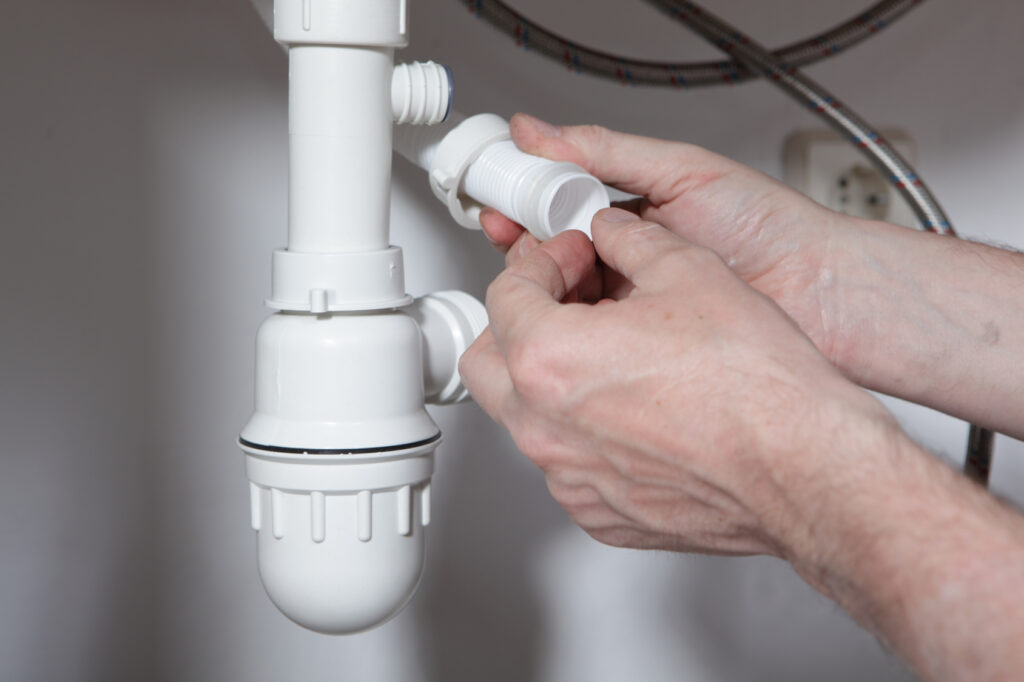We strongly believe in entrusting challenging tasks to professionals here at SOS Drainage & Plumbing Services. We specialize in helping you through processes that are simple enough for you to do without assistance. Emptying the P-trap is one of the quickest and most effective do-it-yourself plumbing repairs. Here are the steps we recommend following for cleaning a P-trap.
What is a P-Trap?
A u-shaped pipe is typically found behind appliances and fixtures that collect and drain water. Often referred to as a P-trap, or plumbing trap, this u-shaped pipe.
Almost all water basins have u-shaped pipes under them. Sometimes, this pipe is referred to as a “plumbing trap,” or P-trap.
Unwanted odors and gases are prevented from going through the pipes by a gravity barrier that is created by the abrupt dip in the u-shape.
The fact that the P-trap is water-filled is one of the main reasons it functions. This water serves as a buffer between your clean home and the foul sewer line.
A P-water trap’s draining can compromise the scented seal. This occurs in sinks that aren’t typically used a lot. Any sink in a guest bathroom or the utility sink comes to mind.
Run the water for a few minutes when this occurs. This ought to produce a fresh barrier and effectively washes out the smell.
Even so, there are situations when running the water won’t be of any help. This is the time to clean a P-trap using the steps listed below.
Materials Needed:
- Bucket – Catch all the water and other debris in your pipes
- Flexible Wire Brush – Great for getting to the bottom of the curved trap.
- Pliers or Adjustable Wrench – Sometimes, the nuts are a little hard to crack.
Step 1: Turn off the Water Tap
The fact that you don’t have to turn off the water to the entire house makes cleaning the P-trap simple. Simply ensure that the sink is not running.
Even when the water is turned off, the P-trap will still be filled with a mess of water and other debris. For this reason, before you even begin to remove the trap, we advise placing the bucket underneath.
Step 2: Remove the P-Trap
The magic takes place here. Most people only use their hands and a washcloth to remove the P-trap.
Remove the nut keeping the P-trap in place while holding the connecting pipe in place. You should be able to remove the P-trap if you repeat the process on the other side.
The moment to use pliers or a wrench is when a trap hasn’t been removed in a while and is stuck in place or when the nuts are excessively tight.
Keep in mind that water will begin to leak from the pipe as soon as the nuts are loosened. Everything is subject to how stuffed the P-trap is.
Carefully remove the P-trap, dump its contents into the bucket, and move on to step 3.
Step 3: Clean the P-Trap
The P-trap is exceedingly simple to clean. Start by manually removing anything that is readily apparent and disposing of it in the bucket or a rubbish bin.
The flexible wire brush is then obtained, used, and put to use. To get rid of any debris that might be inside the pipe, just push the brush through it.
Clean the pipe until the brush is free of any remaining debris.
Step 4: Put Everything Back Together
It’s time to put everything back together now that the pipe is nice and clean. It’s just as simple to disassemble it all as it is to do this.
Make sure the pipe is aligned properly, then screw the nuts back on. Just remember that the pipe’s long end is at the front and its short end is at the back.
Screw the nuts back on.
Don’t force it, however, you might need pliers or a wrench to make sure the seal is tight.
We’re not done yet, though. The pipe still has to be tested.
Watch the P-trap after 15 seconds of running the water. You’re good to finish and tidy things up if there are no leaks.
If you notice water flowing from the nuts, you may need to tighten them or use Teflon tape to improve the seal.
How Often Should I Clean my P-Trap?
At SOS Drainage & Plumbing Services, our plumbers recommend cleaning your P-trap once every three months. This helps keep your line clear and water-free flowing.
Dealing with anything bigger? Time to call the plumbing experts at SOS Drainage & Plumbing Services


